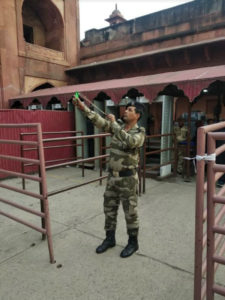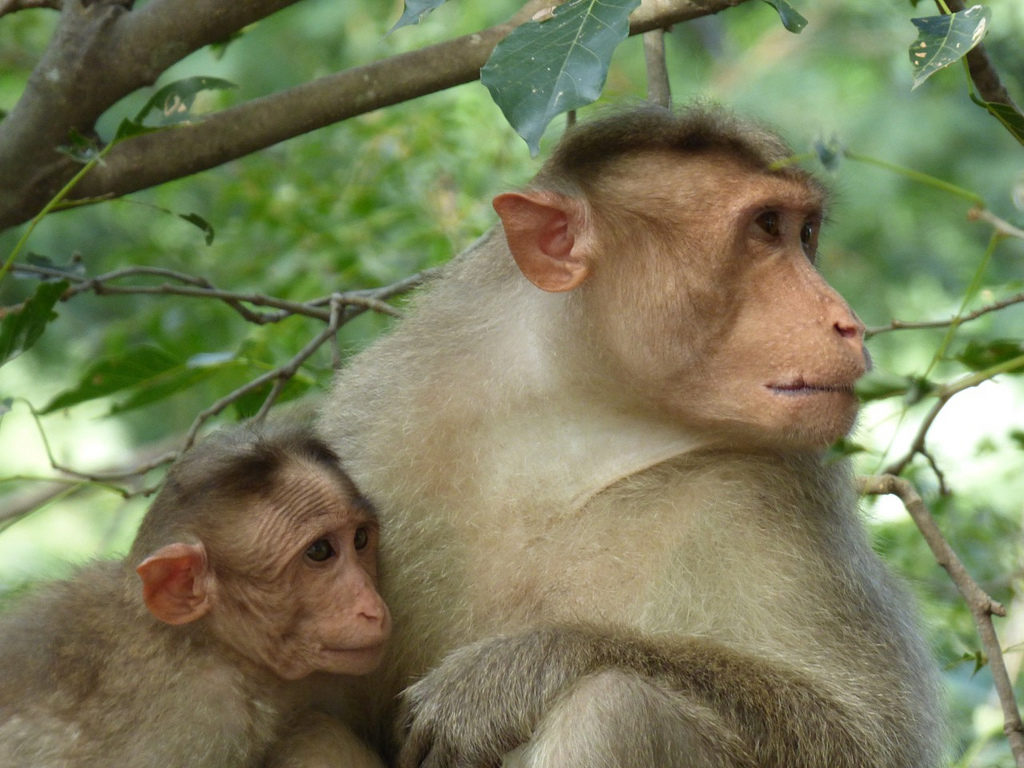International Organization for Animal Protection (OIPA) India has sent a complaint to India’s Ministry of Environment, Forest & Climate Change and the Ministry of Home Affairs. The complaint was lodged against the commandant of the Central Industrial Security Force (CISF) unit responsible for the Taj Mahal area. CISF is an armed force raised under an act of Parliament, which among other tasks, provides security both inside and around the Taj Mahal.

CISF jawans using slingshots to keep monkeys away from the area around the Taj Mahal. Image credit OIPA India.
According to OIPA India, CISF jawans (junior soldiers) have been equipped with slingshots to keep monkeys away from the Taj Mahal monument in the city of Agra. The CISF commandant is therefore held responsible for misuse of power, adopting unethical methods in violation of the Prevention of Cruelty to Animals Act of 1960 and the Wildlife Protection Act of 1972, as well as tarnishing India’s image before the International community.
The species found near the Taj Mahal are rhesus macaques, an Asian monkey species. In India, the country’s majority Hindu population regards monkeys as sacred, as they are associated with the god Hanuman, the monkey deity renowned for his courage, power and faithful, selfless service. Monkeys in India are usually left alone and have an important history with humans.
There are currently 500-700 rhesus macaques living by the Taj Mahal, who forage for food around the entrance of the monument, where visitors’ bags are searched. Tourists are not allowed to carry food into the 17th century monument, and many dump containers in trashcans near its entry gates, attracting the monkeys.
The monkeys have been an issue for a while, but human-monkey conflict has spun out of control more recently with an increase in their numbers.
The threat of an attack is real. Every day, about 25,000 tourists visit the Taj Mahal, rising to 80,000 during the peak tourist season. Incidents of attacks or bites are on the rise. Last November, a monkey snatched a 12-day-old Indian boy from his mother while she was breastfeeding him. The monkey dropped the child on a neighbor’s roof after locals gave chase. The baby died in a hospital from wounds caused by the incident.
Local authorities seem incapable of finding an effective solution to this problem.
Despite the danger, the macaques are protected under the Wildlife Protection Act of 1972. Capturing, hunting, or killing them is a violation of the act, which may lead the offender to a judicial trial with fine, imprisonment, or both.
The root cause of this conflict between humans and rhesus macaques is the eradication of the monkeys’ natural habitat, which has forced them into proximity with humans. As India’s urbanization rapidly expands into forests and wilderness, city blocks replace monkeys’ natural habitat.
The 700 or so rhesus macaques who live by the Taj Mahal are descendants of the monkeys who lived in the area when it was a jungle, centuries ago. As their habitat dwindles, they are becoming more aggressive and less fearful of human activity. They are not used to foraging in the forest anymore, as it is much easier to find scraps of food in the city.

A CISF jawan aims his slingshot at a macaque. The slingshots are unethical as they harm the monkeys and they do nothing to resolve the ongoing issue of human-monkey conflict. Image via OIPA India.
Beside the modern arms they possess, the jawans of CISF are now equipped with “gulel” (locally made slingshots) to fend off the monkeys who harass visitors at the Taj Mahal. The jawans are supposed to use slingshots only to scare the monkeys and drive them away when they get too close to visitors.
An oral contraceptives plan is challenging to implement, as it is difficult to ensure monkeys ingest the correct dosage. Injections are more practical, but at the same time too expensive: a single dose costs nearly 100 United States dollars and lasts one year, after which maintenance shots are necessary. Efforts to move the monkeys to forests are useless, because the monkeys will likely move back into areas where human activity makes food readily available.
Indeed, surgical sterilization is the only effective way to halt the uncontrolled growth of monkey populations near residential communities and touristic sites. Monkeys should be trapped and sterilization should be undertaken. Sterilization is the only lasting solution that can ensure a peaceful coexistence between humans and monkeys.
What you can do to help:
If you live in or visit an area of India where you come into close proximity with monkeys, do not feed the monkeys, do not try to approach them closely or make eye contact, and do not block the path between a mother and her infant. Additionally, please file a complaint against CISF regarding its unethical methods of monkey management.
Featured image: a monkey at the Taj Mahal. Image credit Avinash Bhat, CC BY-SA 3.0.






